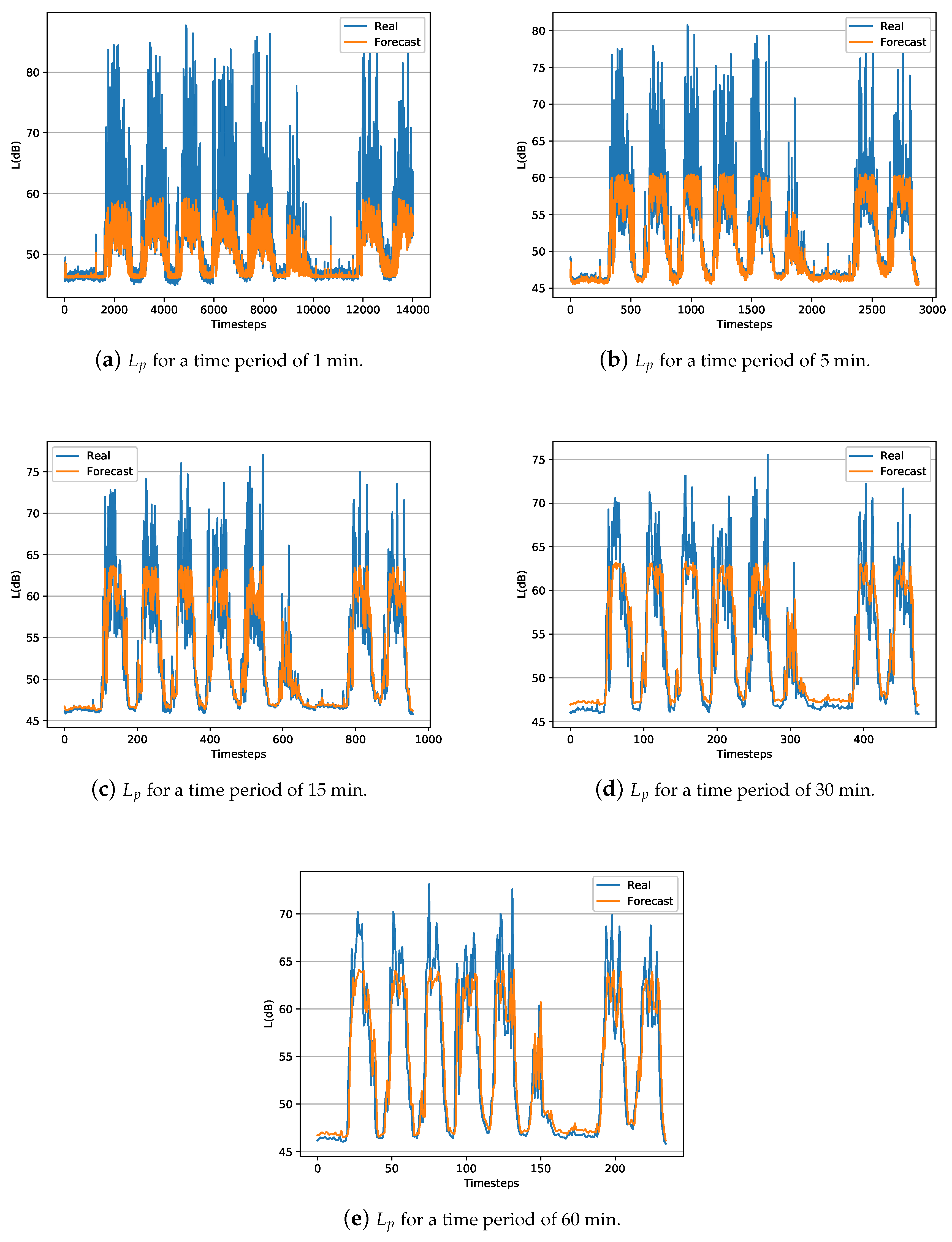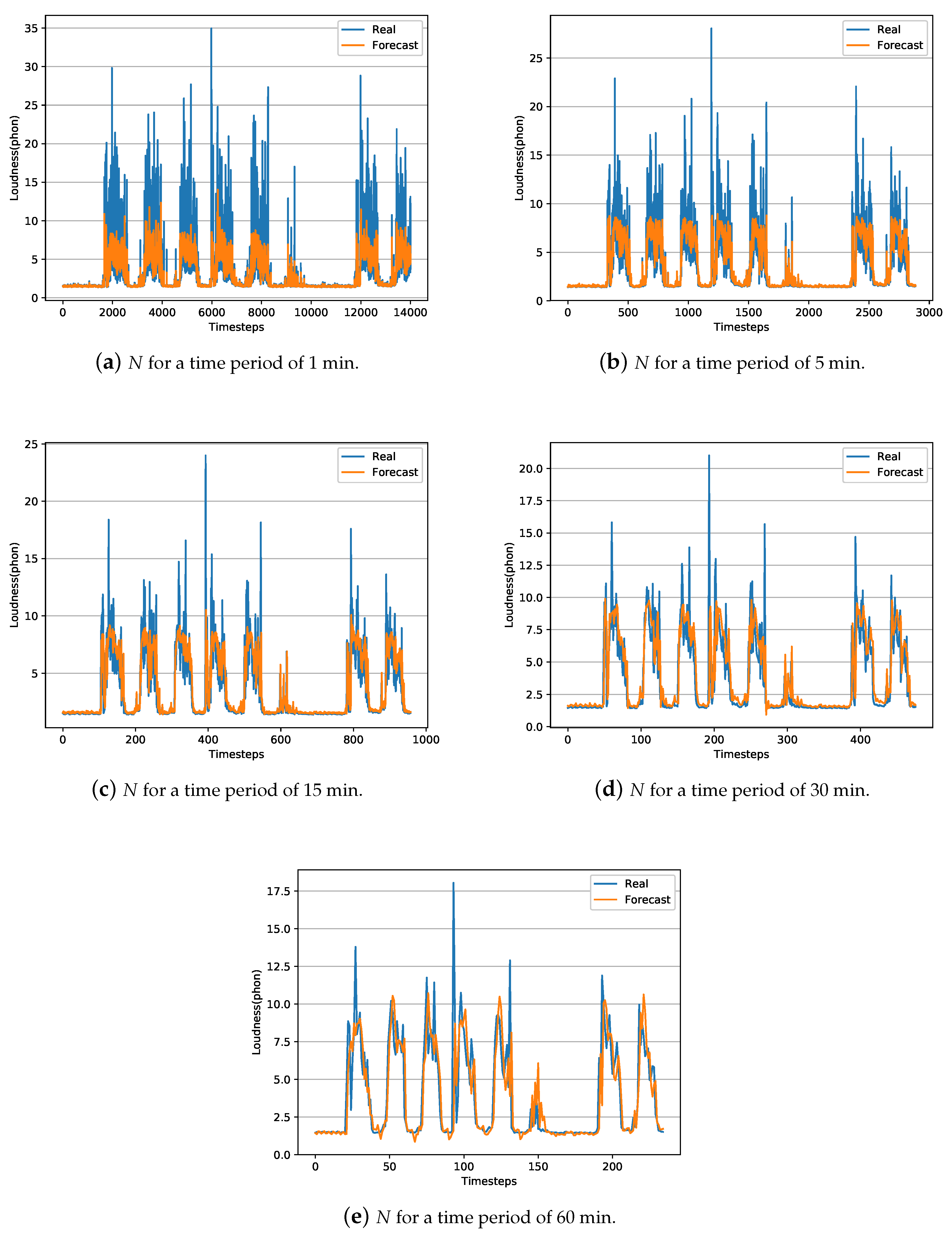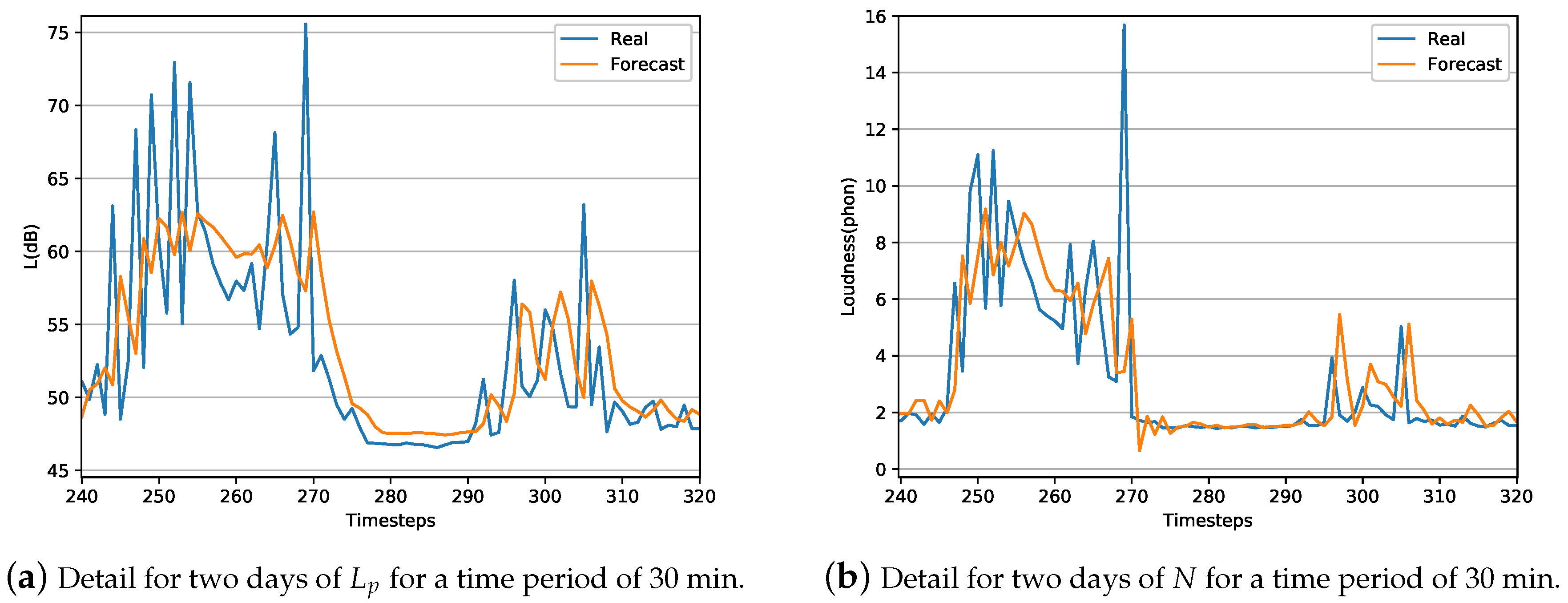Sound Levels Forecasting in an Acoustic Sensor Network Using a Deep Neural Network
Abstract
1. Introduction
2. Related Work
3. Materials and Methods
3.1. Wireless Acoustic Sensor Network
3.2. Acoustic Data-Set
3.3. Deep Learning: Long Short-Term Memory
3.4. Statistical Approach: Auto Regressive Integrated Moving Average
3.5. Experiment Configuration
- the Root Mean Square Error (RMSE)
- the Mean Absolute Error (MAE)
- the Pearson Correlation Coefficient (PCC)
- Determination Coefficient ()
4. Results and Discussion
4.1. Comparing the LSTM Model with the ARIMA Model
4.2. Assessing the Robustness of the Proposed LSTM Model
- 80% train and 20% test (80/20)—approximately 40 days to train and 10 days to test (validation already done in the previous experiment, used to analyze and compare).
- 70% train and 30% test (70/30)—approximately 35 days to train and 15 days to test.
- 60% train and 40% test (60/40)—approximately 30 days to train and 20 days to test.
5. Conclusions and Future Work
Author Contributions
Funding
Conflicts of Interest
References
- European Commission. END, Directive 2002/49/EC of the European Parliament and of the Council of 25 June 2002 relating to the Assessment and Management of Environmental Noise; European Commission: Brussels, Belgium, July 2002. [Google Scholar]
- Hornikx, M. Ten questions concerning computational urban acoustics. Build. Environ. 2016, 106, 409–421. [Google Scholar] [CrossRef]
- Murphy, E.; King, E.A. Strategic environmental noise mapping: Methodological issues concerning the implementation of the EU Environmental Noise Directive and their policy implications. Environ. Int. 2010, 36, 290–298. [Google Scholar] [CrossRef] [PubMed]
- Murphy, E.; Rice, H.J.; Meskell, C. Environmental noise prediction, noise mapping and GIS integration: The case of inner Dublin, Ireland. In Proceedings of the 8th International Transport Noise and Vibration Symposium, St. Petersburg, Russia, 4–6 June 2006. [Google Scholar]
- Arana, M.; Martín, R.S.; Martin, M.L.S.; Aramendía, E. Strategic noise map of a major road carried out with two environmental prediction software packages. Environ. Monit. Assess. 2010, 163, 503–513. [Google Scholar] [CrossRef] [PubMed]
- Garg, N.; Maji, S. A critical review of principal traffic noise models: Strategies and implications. Environ. Impact Assess. Rev. 2014, 46, 68–81. [Google Scholar] [CrossRef]
- Steele, C. A critical review of some traffic noise prediction models. Appl. Acoust. 2001, 62, 271–287. [Google Scholar] [CrossRef]
- Guarnaccia, C. Advanced tools for traffic noise modelling and prediction. WSEAS Trans. Syst. 2013, 12, 121–130. [Google Scholar]
- Barry, T.; Reagan, J.A. FHWA Highway Traffic Noise Prediction Model; U.S. Department of Transportation: Washington, DC, USA, 1978.
- Li, B.; Tao, S.; Dawson, R.W.; Cao, J.; Lam, K. A GIS based road traffic noise prediction model. Appl. Acoust. 2002, 63, 679–691. [Google Scholar] [CrossRef]
- Van Leeuwen, H.J.A. Railway noise prediction models: A comparison. J. Sound Vib. 2000, 231, 975–987. [Google Scholar] [CrossRef]
- Lui, W.K.; Li, K.M.; Ng, P.L.; Frommer, G. A comparative study of different numerical models for predicting train noise in high-rise cities. Appl. Acoust. 2006, 67, 432–449. [Google Scholar] [CrossRef]
- Van Leeuwen, H.J.A. Noise Predictions Models to Determine the Effect of Barriers Placed Alongside Railway Lines. J. Sound Vib. 1996, 193, 269–276. [Google Scholar] [CrossRef]
- Oerlemans, S.; Schepers, J.G. Prediction of wind turbine noise and validation against experiment. Int. J. Aeroacoust. 2009, 8, 555–584. [Google Scholar] [CrossRef]
- Tadamasa, A.; Zangeneh, M. Numerical prediction of wind turbine noise. Renew. Energy 2011, 36, 1902–1912. [Google Scholar] [CrossRef]
- Maisonneuve, M.; Stevens, M.; Ochab, B. Participatory noise pollution monitoring using mobile phones. Inf. Polity 2010, 15, 51–71. [Google Scholar] [CrossRef]
- Akyildiz, I.; Su, W.; Sankarasubramaniam, Y.; Cayirci, E. Wireless sensor networks: A survey. Comput. Netw. 2002, 38, 393–422. [Google Scholar] [CrossRef]
- Peckens, C.; Porter, C.; Rink, T. Wireless sensor networks for long-term monitoring of urban noise. Sensors 2018, 18, 3161. [Google Scholar] [CrossRef]
- Basten, T.; Wessels, P. An overview of sensor networks for environmental noise monitoring. In Proceedings of the 21st International Congress on Sound and Vibration (ICSV21), Beijing, China, 13–17 July 2014. [Google Scholar]
- Alías, F.; Alsina-Pagés, R. Review of Wireless Acoustic Sensor Networks for Environmental Noise Monitoring in Smart Cities. J. Sens. 2019. [Google Scholar] [CrossRef]
- Mydlarz, C.; Salamon, J.; Bello, J.P. The implementation of low-cost urban acoustic monitoring devices. Appl. Acoust. 2017, 117, 207–218. [Google Scholar] [CrossRef]
- Camps-Farrés, J. Barcelona noise monitoring network. In Proceedings of the EuroNoise 2015, Maastricht, The Netherlands, 31 May–3 June 2015; pp. 2315–2320. [Google Scholar]
- Bartalucci, C.; Borchi, F.; Carfagni, M.; Furferi, R.; Governi, L. Design of a prototype of a smart noise monitoring system. In Proceedings of the 24th International Congress on Sound and Vibration (ICSV24), London, UK, 23–27 July 2017; pp. 1–8. [Google Scholar]
- Mietlicki, C.; Mietlicki, F. Medusa, a new approach for noise management and control in urban environment. In Proceedings of the 11th European Congress and Exposition on Noise Control Engineering (Euronoise2018), Crete, Greece, 27–31 May 2018; pp. 727–730. [Google Scholar]
- Navarro, J.M.; Tomas-Gabarron, J.B.; Escolano, J. A big data framework for urban noise analysis and management in smart cities. Acta Acust. United Acust. 2017, 103, 552–560. [Google Scholar] [CrossRef]
- Langkvist, M.; Karlsson, L.; Loutfi, A. A review of unsupervised feature learning and deep learning for time-series modeling. Pattern Recognit. Lett. 2014, 42, 11–24. [Google Scholar] [CrossRef]
- Che, Z.; Purushotham, S.; Cho, K.; Sontag, D.; Liu, Y. Recurrent neural networks for multivariate time series with missing values. Sci. Rep. 2018, 8, 1–12. [Google Scholar] [CrossRef]
- Wittenburg, G.; Dziengel, N.; Wartenburger, C.; Schiller, J. A system for distributed event detection in wireless sensor networks. In Proceedings of the 9th ACM/IEEE International Conference on Information Processing in Sensor Networks (IPSN’10), Stockholm, Sweden, 12–16 April 2010; pp. 94–104. [Google Scholar]
- Kim, H.G.; Kim, J.Y. Environmental sound event detection in wireless acoustic sensor networks for home telemonitoring. China Commun. 2017, 14, 1–10. [Google Scholar] [CrossRef]
- Luque, A.; Romero-Lemos, J.; Carrasco, A.; Barbancho, J. Improving Classification Algorithms by Considering Score Series in Wireless Acoustic Sensor Networks. Sensors 2018, 18, 2465. [Google Scholar] [CrossRef] [PubMed]
- Zhang, Y.; Fu, Y.; Wang, R. Collaborative representation based classification for vehicle recognition in acoustic sensor networks. J. Comput. Methods Sci. Eng. 2018, 18, 349–358. [Google Scholar] [CrossRef]
- Cobos, M.; Perez-Solano, J.J.; Felici-Castell, S.; Segura, J.; Navarro, J.M. Cumulative-sum-based localization of sound events in low-cost wireless acoustic sensor networks. IEEE/ACM Trans. Audio Speech Lang. Process. 2014, 22, 1792–1802. [Google Scholar] [CrossRef]
- Sevillano, X.; Socoró, J.C.; Alías, F.; Bellucci, P.; Peruzzi, L.; Radaelli, S.; Benocci, R. DYNAMAP— Development of low cost sensors networks for real time noise mapping. Noise Mapp. 2016, 3, 172–189. [Google Scholar] [CrossRef]
- Segura-Garcia, J.; Navarro-Ruiz, J.; Perez-Solano, J.; Montoya-Belmonte, J.; Felici-Castell, S.; Cobos, M. Torres-Aranda, Spatio-Temporal Analysis of Urban Acoustic Environments with Binaural Psycho-Acoustical Considerations for IoT-Based Applications. Sensors 2018, 18, 690. [Google Scholar] [CrossRef]
- Bello, J.P.; Silva, C.; Nov, O.; Dubois, R.L.; Arora, A.; Salamon, J.; Doraiswamy, H. SONYC: A system for monitoring, analyzing, and mitigating urban noise pollution. Commun. ACM 2019, 62, 68–77. [Google Scholar] [CrossRef]
- Jakob, A.; Marco, G.; Stephanie, K.; Robert, G.; Christian, K.; Tobias, C.; Hanna, L. A Distributed Sensor Network for Monitoring Noise Level and Noise Sources in Urban Environments. In Proceedings of the 2018 IEEE 6th International Conference on Future Internet of Things and Cloud (FiCloud), Barcelona, Spain, 6–8 August 2018; pp. 318–324. [Google Scholar]
- Socoró, J.; Alías, F.; Alsina-Pagès, R. An anomalous noise events detector for dynamic road traffic noise mapping in real-life urban and suburban environments. Sensors 2017, 17, 2323. [Google Scholar] [CrossRef]
- Li, Y.; Liu, M.; Drosos, K.; Virtanen, T. Sound event detection via dilated convolutional recurrent neural networks. arXiv 2019, arXiv:1911.10888. [Google Scholar]
- Yu, L.; Kang, J. Modeling subjective evaluation of soundscape quality in urban open spaces: An artificial neural network approach. J. Acoust. Soc. Am. 2009, 126, 1163–1174. [Google Scholar] [CrossRef]
- Lopez-Ballester, J.; Pastor-Aparicio, A.; Segura-Garcia, J.; Felici-Castell, S.; Cobos, M. Computation of Psycho-Acoustic Annoyance Using Deep Neural Networks. Appl. Sci. 2019, 9, 3136. [Google Scholar] [CrossRef]
- Mansourkhaki, A.; Berangi, M.; Haghiri, M.; Haghani, M. A neural network noise prediction model for Tehran urban roads. J. Environ. Eng. Landsc. Manag. 2018, 26, 88–97. [Google Scholar] [CrossRef]
- Pedersen, K.; Transtrum, M.K.; Gee, K.L.; Butler, B.A.; James, M.M.; Salton, A.R. Machine learning-based ensemble model predictions of outdoor ambient sound levels. Proc. Meet. Acoust. 2018, 35, 022002. [Google Scholar]
- Torija, A.J.; Ruiz, D.P.; Ramos-Ridao, A.F. Use of back-propagation neural networks to predict both level and temporal-spectral composition of sound pressure in urban sound environments. Build. Environ. 2012, 52, 45–56. [Google Scholar] [CrossRef]
- Garg, N.; Soni, K.; Saxena, T.K.; Maji, S. Applications of Autoregressive integrated moving average (ARIMA) approach in time-series prediction of traffic noise pollution. Noise Control. Eng. J. 2015, 63, 182–194. [Google Scholar] [CrossRef]
- Tong, W.; Li, L.; Zhou, X.; Hamilton, A.; Zhang, K. Deep learning PM 2.5 concentrations with bidirectional LSTM RNN. Air Qual. Atmos. Health 2019, 12, 411–423. [Google Scholar] [CrossRef]
- Krishan, M.; Jha, S.; Das, J.; Singh, A.; Goyal, M.K.; Sekar, C. Air quality modelling using long short-term memory (LSTM) over NCT-Delhi, India. Air Qual. Atmos. Health 2019, 12, 899–908. [Google Scholar] [CrossRef]
- Noriega-Linares, J.E.; Rodriguez-Mayol, A.; Cobos, M.; Segura-Garcia, J.; Felici-Castell, S.; Navarro, J.M. A Wireless Acoustic Array System for Binaural Loudness Evaluation in Cities. IEEE Sens. J. 2017, 17, 7043–7052. [Google Scholar] [CrossRef]
- Raspberry PI. Available online: https://www.raspberrypi.org (accessed on 6 February 2020).
- Zwicker, E.; Fastl, H. Psychoacoustics: Facts and Models; Springer: Berlin, Germany, 2013; Volume 22. [Google Scholar]
- Hochreiter, S.; Schmidhuber, J. LSTM can solve hard long time lag problems. In Proceedings of the 9th International Conference on Neural Information Processing Systems, Denver, CO, USA, 3–5 December 1996; pp. 473–479. [Google Scholar]
- Brockwell, P.J.; Davis, R.A. Introduction to Time Series and Forecasting; Springer: Berlin, Germany, 2016. [Google Scholar]
- Box, G.E.; Jenkins, G.M. Time Series Analysis. Forecasting and Control, Revised ed.; In Holden-Day Series in Time Series Analysis; Holden-Day: San Francisco, CA, USA, 1976. [Google Scholar]
- Legates, D.R.; McCabe, G.J., Jr. Evaluating the use of “goodness-of-fit” measures in hydrologic and hydroclimatic model validation. Water Resourc. Res. 1999, 35, 233–241. [Google Scholar] [CrossRef]




| Data-Sets | Total Instances L | Total Instances N |
|---|---|---|
| noise01 | 72,300 | 72,300 |
| noise05 | 14,460 | 14,460 |
| noise15 | 4820 | 4820 |
| noise30 | 2410 | 2410 |
| noise60 | 1205 | 1205 |
| Parameter | Value |
|---|---|
| Number of input neurons | [50:100] |
| N[17:70] | |
| Batch size | 32 |
| Number of epochs | 100 |
| Learning factor | 0.001 |
| Optimizer | Adam |
| Activation function | hyperbolic tangent |
| Loss Function | quadratic mean error |
| Delay Sequence | 6 |
| -noise60 | -noise30 | -noise15 | -noise05 | -noise01 | ||||||
|---|---|---|---|---|---|---|---|---|---|---|
| ARIMA | LSTM | ARIMA | LSTM | ARIMA | LSTM | ARIMA | LSTM | ARIMA | LSTM | |
| RMSE | 9.3000 | 3.9400 | 112.0704 | 4.2700 | 9.5734 | 4.2500 | 78.2656 | 3.9500 | 6.0694 | 3.5900 |
| MAE | 6.6400 | 2.7500 | 2.2050 | 2.8500 | 7.7755 | 2.5500 | 5.8934 | 2.0700 | 4.4851 | 1.7100 |
| PCC | 0.1732 | 0.8600 | 0.0131 | 0.8300 | 0.2798 | 0.8100 | 0.0335 | 0.8100 | 0.0521 | 0.8000 |
| 0.0300 | 0.7500 | 0.0002 | 0.6900 | 0.0783 | 0.6600 | 0.0011 | 0.6400 | 0.0027 | 0.5800 | |
| N-noise60 | N-noise30 | N-noise15 | -noise05 | N-noise01 | ||||||
|---|---|---|---|---|---|---|---|---|---|---|
| ARIMA | LSTM | ARIMA | LSTM | ARIMA | LSTM | ARIMA | LSTM | ARIMA | LSTM | |
| RMSE | 3.1100 | 1.9900 | 14.6412 | 2.0100 | 8.4290 | 1.9600 | 12.3481 | 1.8700 | 3.1400 | 1.7900 |
| MAE | 2.7100 | 0.9900 | 2.2050 | 1.0500 | 2.0675 | 1.0000 | 1.8617 | 0.8900 | 0.1563 | 0.7400 |
| PCC | 0.2000 | 0.7900 | 0.0198 | 0.7800 | 0.3769 | 0.7800 | 0.0031 | 0.7800 | 0.0011 | 0.7600 |
| 0.0400 | 0.6000 | 0.0004 | 0.5900 | 0.1420 | 0.6000 | 0.0000 | 0.6100 | 0.0000 | 0.5700 | |
| Sound Pressure Level | Loudness | ||||||||
|---|---|---|---|---|---|---|---|---|---|
| Data-Set | Train/Test | RMSE | MAE | PCC | RMSE | MAE | PCC | ||
| noise30 | 80/20 | 4.27 | 2.85 | 0.83 | 0.69 | 2.01 | 1.05 | 0.78 | 0.59 |
| 70/30 | 4.32 | 2.74 | 0.82 | 0.68 | 2.08 | 1.09 | 0.77 | 0.59 | |
| 60/40 | 4.51 | 3.15 | 0.84 | 0.65 | 2.00 | 1.05 | 0.80 | 0.63 | |
| noise60 | 80/20 | 3.94 | 2.75 | 0.86 | 0.75 | 1.99 | 0.99 | 0.79 | 0.60 |
| 70/30 | 4.13 | 2.92 | 0.85 | 0.72 | 2.03 | 1.17 | 0.79 | 0.61 | |
| 60/40 | 4.05 | 3.13 | 0.86 | 0.74 | 1.97 | 1.14 | 0.82 | 0.65 | |
© 2020 by the authors. Licensee MDPI, Basel, Switzerland. This article is an open access article distributed under the terms and conditions of the Creative Commons Attribution (CC BY) license (http://creativecommons.org/licenses/by/4.0/).
Share and Cite
Navarro, J.M.; Martínez-España, R.; Bueno-Crespo, A.; Martínez, R.; Cecilia, J.M. Sound Levels Forecasting in an Acoustic Sensor Network Using a Deep Neural Network. Sensors 2020, 20, 903. https://doi.org/10.3390/s20030903
Navarro JM, Martínez-España R, Bueno-Crespo A, Martínez R, Cecilia JM. Sound Levels Forecasting in an Acoustic Sensor Network Using a Deep Neural Network. Sensors. 2020; 20(3):903. https://doi.org/10.3390/s20030903
Chicago/Turabian StyleNavarro, Juan M., Raquel Martínez-España, Andrés Bueno-Crespo, Ramón Martínez, and José M. Cecilia. 2020. "Sound Levels Forecasting in an Acoustic Sensor Network Using a Deep Neural Network" Sensors 20, no. 3: 903. https://doi.org/10.3390/s20030903
APA StyleNavarro, J. M., Martínez-España, R., Bueno-Crespo, A., Martínez, R., & Cecilia, J. M. (2020). Sound Levels Forecasting in an Acoustic Sensor Network Using a Deep Neural Network. Sensors, 20(3), 903. https://doi.org/10.3390/s20030903







